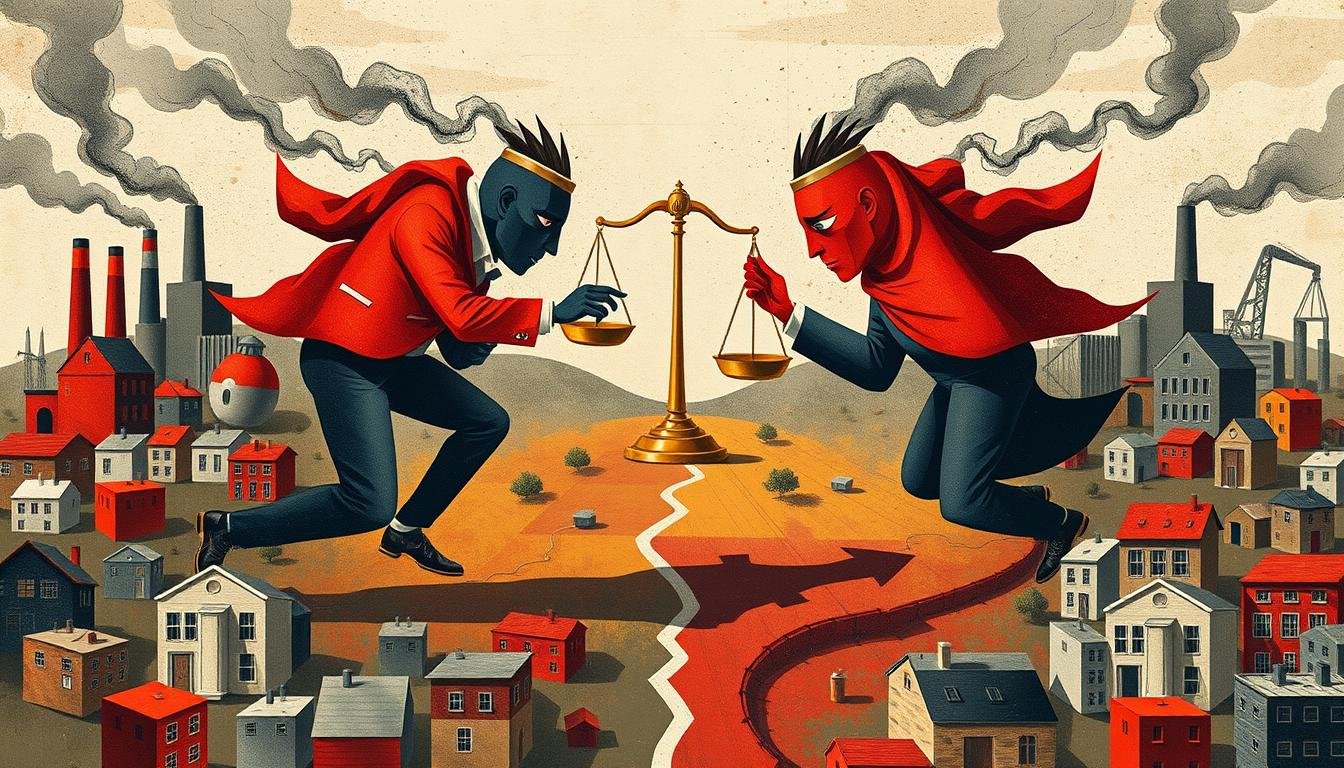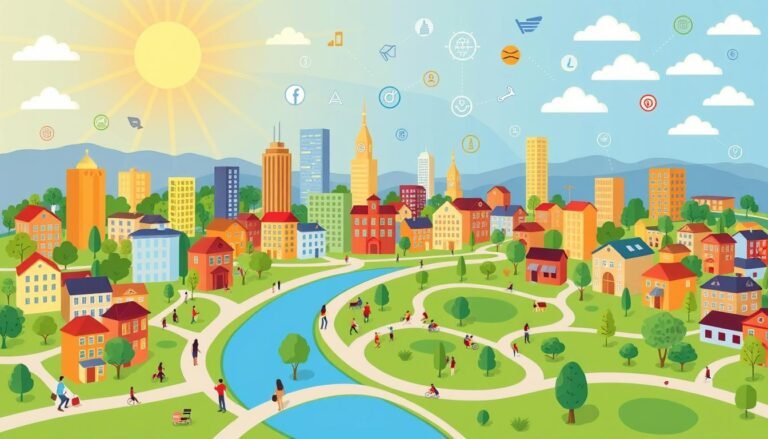Conflict Theory: Analyzing Power Dynamics in Society
Ever wondered why some groups seem to have more power than others? This question is key to conflict theory, a way to look at power in society. It helps us see how things like social inequality and class struggles work.
Karl Marx first came up with conflict theory. He said society is always in tension. He believed that fighting over limited resources shapes our social world and power structures. This idea helps us understand economic differences and power imbalances in our lives.
Conflict theory looks at how different groups fight for control over resources and power. It shows us the battles between those in charge and those left behind. It points out how not everyone gets the same wealth, status, or chances in life.
Key Takeaways
- Conflict theory focuses on power differentials and class struggles in society
- It views society as being in constant competition for limited resources
- Karl Marx’s work is central to conflict theory, emphasizing economic disparities
- The theory highlights the exploitation of the proletariat by the bourgeoisie
- Conflict theory has evolved over time, influenced by various sociological thinkers
- It provides a framework for understanding social inequalities and power dynamics
The Essence of Conflict Theory
Conflict theory helps us see society as a place of power struggles and class conflicts. It shows how social layers affect our world. At its heart, it looks at how different groups fight over limited resources.
Defining Conflict Theory
Conflict theory views society as a place where different groups clash. It looks at how power and economic gaps drive social change. This idea is different from theories that focus on society’s harmony and stability.
Karl Marx’s Contribution
Karl Marx, known as the “Father of Conflict Theory,” developed this idea in the 19th century. He saw society as divided into two main groups: the working class and the capitalists. Marx thought that who controlled production was key to this division.
Competition for Limited Resources
At the core of conflict theory is the fight for limited resources. This fight creates tension between those who have more and those who have less. The theory says that those with more resources try to keep them, while those with less try to get more.
| Aspect | Conflict Theory Perspective |
|---|---|
| Society | Battlefield of opposing interests |
| Power | Unequally distributed |
| Resources | Limited and competed for |
| Social Change | Result of conflict between groups |
Conflict theory helps us understand social dynamics. It shows how power struggles and class conflicts affect society. This includes everything from workplace issues to political systems.
Historical Development of Conflict Theory
Karl Marx started conflict theory in the 19th century. He looked at class struggle and capitalism to understand power in society. Marx saw society as a fight for limited resources among groups with different power levels.
Marx noticed how the working class was being exploited during industrialization, especially in steel factories. This led him to talk about alienation. Workers felt disconnected from their work, others, and themselves. Marx believed workers should understand their true social position and work for change.
Friedrich Engels wrote “The Condition of the Working-Class in England” in 1844. It highlighted the tough working conditions and social unfairness. With Marx, they wrote “The Communist Manifesto” in 1848. This called for workers to unite against the rich to change society.
Conflict theory grew to include more than just economic class. It now looks at race, gender, and other social differences. Scholars like Max Weber added to the theory. They explained power struggles based on social identity.
Conflict theory sees society as a place of power struggles. It talks about social inequality and the fight for resources. It says that society’s structure comes from these power struggles. This leads to ongoing fights between those in power and those who are not.
This view helps us understand issues like oppression and how society changes. It’s important for seeing how some groups control others.
Key Aspects of Conflict Theory
Conflict theory looks closely at social inequality and power struggles. It shows how society is shaped by competition and conflict among different groups.
Economic Disparity
Economic disparity is central to conflict theory. It says resources are not shared equally, causing a big gap between rich and poor. The rich elite control society, keeping the poor down and making social inequality worse.
Power Dynamics
Power is key in conflict theory. Those in charge use their power to stay on top, often hurting others. This leads to a cycle of oppression where the powerful keep getting ahead, while the weak can’t escape their tough situation.
Social Change
Conflict theory believes social change comes from conflicts between groups. As these conflicts grow and inequalities get clearer, groups left behind might stand up. This can lead to big changes in society and how power is shared.
| Aspect | Impact on Society |
|---|---|
| Economic Disparity | Widening wealth gap, limited social mobility |
| Power Dynamics | Oppression, discrimination, unequal opportunities |
| Social Change | Protests, reforms, shifts in power structures |
Looking at these key points, conflict theory helps us see how economic forces, power, and social change work together in our society.
The Role of Social Stratification in Conflict Theory
Social stratification is key to conflict theory. It puts society into layers based on wealth, power, and status. This setup means some get more resources than others, causing class conflict and power fights.
Conflict theorists say that stratification keeps social inequality going. The top people control the resources and shape society for their benefit. This makes it hard for the poor to move up in life.
Karl Marx’s ideas helped us understand class conflict. He saw society as divided between the bourgeoisie (owners) and the proletariat (workers). This shows how power is not evenly shared in capitalist societies.
“The history of all hitherto existing society is the history of class struggles.” – Karl Marx
Today, conflict theory looks at more than just money issues. It also looks at race, gender, and other things that make society unequal. This wider view helps us see the complex ways power works in our world.
| Social Class | Access to Resources | Power Level |
|---|---|---|
| Upper Class | High | Strong |
| Middle Class | Moderate | Limited |
| Working Class | Low | Weak |
Conflict theory says social stratification is not good or needed. It believes this system keeps inequality going, causing ongoing social conflicts and power fights.
Class Conflict: The Core of Marxist Theory
Class conflict is central to Marxist theory. It shows how power and wealth spread unevenly in society. Karl Marx saw society divided into three main groups: the bourgeoisie, landowners, and the proletariat.
Bourgeoisie vs. Proletariat
The bourgeoisie control the means of production and pay workers for their labor. This setup leads to a power imbalance, making workers feel exploited and disconnected. Marx thought this would lead to a revolution by workers, ending private ownership and creating a society without classes.
Means of Production
Having control over production gives political power, which the bourgeoisie use to protect their wealth. This control shapes how society is structured and class relationships. Ralf Dahrendorf added to this idea, seeing classes as groups with authority, not just about owning property.
Class Consciousness
Class consciousness means workers know their social class and what they have in common. As workers become more aware, the fight against class grows. It moves from individual workplaces to wider social issues. Understanding class helps us see how power works in society and can lead to change.
Recent studies show class conflict is still important today. For instance, Ahn et al. (2016) found that income inequality in the U.S. affects how happy workers are. This shows how economic differences still impact people’s lives.
Power Struggles in Contemporary Society
Power struggles shape our modern world, showing the fight for resources and influence. These conflicts come in many forms, like economic gaps and political moves. Antonio Gramsci’s idea of hegemony shows how top groups keep power by controlling culture and ideas.
In the U.S., the top 0.5% to 1% own more than half the wealth. This economic power means they also have a big say in politics. For example, the oil and gas industry spent a lot on lobbying in 2009, showing how money affects laws.
These power dynamics keep social inequality going. The U.S. has weak laws against pollution, showing how big companies can put public health last. BP’s big donations to politicians and lobbying in 2008-2009 also show this issue.
“Power can be exercised through coercion or consent, seen in authoritarian regimes or democratic governments, respectively.”
Oppression is a big problem today. Groups like African Americans and women still face many hurdles. Michel Foucault’s idea of biopower explains how power controls our lives, like our health and sexuality, making social gaps bigger.
It’s important to understand these power struggles to tackle social problems and aim for fairness. By seeing how economic, political, and social factors work together, we can tackle today’s big challenges.
Conflict Theory: Analyzing Power Dynamics in Society
Conflict theory looks at how power affects our society. It shows us how some people have more power than others. This leads to social structures that help certain groups more than others. The theory believes conflict is natural because of these power imbalances.
Unequal Distribution of Power
Power is not spread evenly in society. Those with more power keep their advantage. This creates a cycle where the top stays the same. Research by Briscoe et al. (2021) showed how race and sex affect well-being, proving power imbalances hurt different groups.
Social Structures Benefiting Certain Groups
Social structures often help some groups more than others. This leads to ongoing conflicts. For instance, Armstrong and Stedman (2013) studied culture clashes over property. They found second-home owners often had more say than locals, showing how resources can influence social structures.
Inevitability of Conflict
Conflict theory says change often comes from conflict. The 2008 financial crisis is a good example. It showed how global economic inequalities led to big conflicts and bailouts. This event sparked talks on wealth distribution and financial rules, pushing for economic changes.
| Aspect | Impact on Society |
|---|---|
| Unequal Power Distribution | Creates and maintains elite dominance |
| Biased Social Structures | Perpetuate inequalities among groups |
| Inevitable Conflict | Drives societal change and reform |
Applications of Conflict Theory in Various Social Contexts
Conflict theory shows us how power works in different social areas. It helps us see how social class affects many parts of our lives.
Education
In schools, conflict theory points out how education can keep social inequalities going. The U.S. Department of Commerce found in 2011 that gender roles lead to a gap in STEM fields. This shows how schools can keep power structures in place.
Race and Ethnicity
Conflict theory sheds light on racial tensions and unfairness. For instance, women in the U.S. didn’t get the right to vote until 1920. This shows historical struggles for power. Gay and lesbian couples faced marriage bans in some places, showing ongoing class conflicts based on who they are.
Healthcare
In healthcare, conflict theory uncovers differences in getting care and health outcomes by social class. These gaps often mirror deeper power imbalances in society. The theory shows how social class affects important health services.
Some say conflict theory focuses too much on money issues. But its ideas are still key to understanding today’s social changes. From schools to hospitals, this view helps us see how power and change work in our world.
Critiques and Limitations of Conflict Theory
Conflict theory is key in understanding power in society but has its downsides. Critics say it overemphasizes conflict and economic aspects in social interactions. This can miss the cooperation and mutual benefits in many social ties.
A big issue is its simplification of complex social structures. It mainly looks at class struggles, missing out on culture, technology, or individual actions. This can give a partial view of social dynamics.
Another issue is its struggle to explain social progress. Conflict theory is great at spotting power imbalances. Yet, it finds it hard to explain positive changes without conflict. This makes it tough to use the theory for peaceful, gradual reforms.
“Conflict theory provides valuable insights, but it’s not a one-size-fits-all explanation for social phenomena,” notes Dr. Sarah Johnson, a prominent sociologist.
Some critics believe conflict theory doesn’t value consensus and stability enough. It focuses too much on change through conflict. This might ignore the role of shared values and norms in keeping societies stable.
Even with its flaws, conflict theory is still vital in critical theory and social analysis. It sheds light on power dynamics and structural inequalities. Scholars keep working to improve it.
Modern Adaptations and Extensions of Conflict Theory
Conflict theory has grown to tackle the complexities of today’s society. It shows how social inequality and power dynamics have changed. Let’s see how this old theory now explains changes in our society.
Weber’s Contribution
Max Weber took conflict theory further by looking at more than just economic classes. He added status and party affiliations to the mix. This gives us a deeper look at how power affects different social groups, not just the economy.
Emotional Component in Conflict
Weber also highlighted the emotional side of conflict. This is key to understanding modern conflicts. For instance, the 2003 invasion of Iraq sparked many emotions, leading to ongoing violence. Even after US troops left, violence didn’t stop, showing the lasting effects of conflict.
Identity Studies and Conflict Theory
Today, conflict theory looks at racial and sexual inequality too. This helps us understand conflicts like civil wars based on ethnicity. Studies show that differences between ethnic groups can cause problems in developing countries. These updates show conflict theory is still useful in grasping today’s social issues.
Source Links
- Conflict theories
- Conflict Theory: Assumption, Causes, Limitations and Examples – GeeksforGeeks
- Nerdfighteria Wiki – Karl Marx & Conflict Theory: Crash Course Sociology #6
- Turner1
- Conflict Theory: Analyzing Struggles Over Resources and Power – Psychology for everyone
- Conflict Theory and Society | Introduction to Sociology
- Conflict Theory
- Conflict Theory in Sociology
- Understanding Conflict Theories in Sociology
- Power dynamics: Power Struggles Unveiled: A Conflict Theory Analysis – FasterCapital
- Conflict Theory Definition, Founder, and Examples
- Theoretical Perspectives on Social Stratification
- MARXISM AND CLASS CONFLICT
- LibGuides: Social Work Theories: Conflict Perspective
- Theories of Power and Society
- Understanding Power Dynamics in Sociology
- Understanding Social Conflict Theory – ADR Times
- Conflict Theory on Culture and Technology
- Conflict Theory | Introduction to Sociology
- Conflict Theory explained including examples
- The dynamics of cooperation, power, and inequality in a group-structured society
- sres2132 1..20







